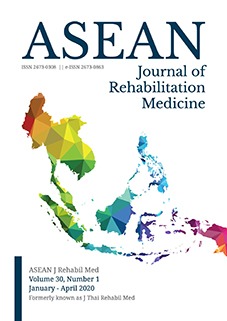Prevalence of Complementary and Alternative Medicine Used by Stroke Patients in Siriraj Hospital, Thailand
Keywords:
complementary medicine, alternative medicine, poststroke, prevalence, Thai traditional medicineAbstract
Objectives: To study the prevalence of complementary and alternative medicine (CAM) use and related factors among stroke patients in Siriraj Hospital.
Study design: Cross-sectional descriptive study.
Setting: Inpatient and outpatient of the Departments of Internal Medicine and Rehabilitation Medicine, Siriraj Hospital.
Subjects: Stroke patients (at least 3 months after onset), age at least 18 years.
Methods: Data collected by questionnaire-based study on stroke patients or their relatives.
Results: Three hundred and nine stroke patients were recruited, 59.2% were male. Mean age was 65.2 (SD 12.3) years. The prevalence of CAM use in stroke patients was 40.8%. The most common CAM used was Thai massage (56.3%) followed by acupuncture (44.4%), traditional Thai herb and medication (36.5%) and traditional Chinese herb and medicine (15.9%). The main reasons for CAM used were muscle strength improvement (58.7%), controlling spasticity (41.3%), improving walking ability (37.3%), and pain reduction (25.4%). Treatments with CAM started from suggestions from families or friends (58.7%) and physicians and healthcare professions (23.8%). The total cost per month of CAM use that was less than 1,000 baht was 40.5%. Complication rate was 16.7%. Ecchymosis or bruise was the most common complication. Regarding satisfaction rate, CAM users rated extremely satisfied, satisfied and neutral 19.0%, 48.4% and 27.0%, respectively.
Conclusion: About 40% of stroke patients used CAM. The frequent CAM treatments chosen were traditional Thai and Chinese medicine suggested by their relatives and friends. Though, there were some complications, stroke patients were still satisfied with CAM.
References
International Health Policy Program Ministry of Public Health. Disability-adjusted life year: DALY. Bangkok: WVO officer of printing mill; 2554 BE [cited 2019 August 22]. Available from: https://bodthai.net/download/%E0%B8%A3%E0%B8%B2%E0%B8%A2%E0%B8%87%E0%B8%B2%E0%B8%99%E0%B8%A0%E0%B8%B2%E0%B8%A3%E0%B8%B0%E0%B9%82%E0%B8%A3%E0%B8%84-2554/.
Pandian JD, Liu M, Misbach J, Venketasubramanian N. Alternative therapies for stroke treatment in Asia. Int J Stroke. 2011;6:541-3.
Division of complementary and alternative medicine. Complementary and alternative medicine in Thailand [cited 2015 September 02]. Available from: https://thaicam.go.th/%e0%b8%aa%e0%b8%96%e0%b8%b2%e0%b8%99%e0%b8%81%e0%b8%b2%e0%b8%a3%e0%b8%93%e0%b9%8c%e0%b8%81%e0%b8%b2%e0%b8%a3%e0%b9%81%e0%b8%9e%e0%b8%97%e0%b8%a2%e0%b9%8c%e0%b8%97%e0%b8%b2%e0%b8%87%e0%b9%80%e0%b8%a5/.
World Health Organization. Traditional, complementary and integrative medicine [cited 2015 September 2]. Available from: https://www.who.int/traditional-complementary-integrative-medicine/about/en/.
Satientrat P. Situation of Thai traditional medicine in public health care facilities in Thailand. In: Patragat P, Junket R, editors. Report of Thai traditional medicine, folk medicine and alternative medicine year 2548-2550BE. Bangkok: Manas Film; 2007.
Kaeowichian N. Knowledge in caring for elderly stroke with traditional Thai medicine and alternative medicine. [cited 2015 September 14]. Available from: https://www.thaicam.go.th/index.php?option=com_content&view=category&id=102&Itemid=160.
Pandian JD, Toor G, Arora R, Kaur P, Dheeraj KV, Bhullar RS, et al. Complementary and alternative medicine treatments among stroke patients in India. Top Stroke Rehabil. 2012;19:384-94.
Blackmer J, Jefromova L. The use of alternative therapies in the Saskatchewan stroke rehabilitation population. BMC Complement Altern Med. 2002;2:7.
Shah SH, Engelhardt R, Ovbiagele B. Patterns of complementary and alternative medicine use among United States stroke survivors. J Neurol Sci. 2008;271:180-5.
Kadir AA, Hamid AH, Mohammad M. Pattern of complementary and alternative medicine use among Malaysian stroke survivors: A hospital-based prospective study. J Tradit Complement Med. 2015;5:157-60.
Shin YI, Yang CY, Joo MC, Lee SG, Kim JH, Lee MS. Patterns of using complementary and alternative medicine by stroke patients at two university hospitals in Korea. Evid Based Complement Alternat Med. 2008;5:231-5.
Doshi VS, Say JH, Young SH, Doraisamy P. Complications in stroke patients: a study carried out at the Rehabilitation Medicine Service, Changi General Hospital. Singapore Med J. 2003;44:643-52.
Otegbayo JA, Talabi OA, Akere A, Owolabi MO, Owolabi LF, Oguntoye OO. Gastrointestinal complications in stroke survivors. Trop Gastroenterol. 2006;27:127-30.
Bracci F, Badiali D, Pezzotti P, Scivoletto G, Fuoco U, Di Lucente L, et al. Chronic constipation in hemiplegic patients. World J Gastroenterol. 2007;13:3967-72.
Li J, Yuan M, Liu Y, Zhao Y, Wang J, Guo W. Incidence of constipation in stroke patients: a systematic review and meta-analysis. Medicine (Baltimore). 2017;96:e7225.
Lin CJ, Hung JW, Cho CY, Tseng CY, Chen HY, Lin FC, et al. Poststroke constipation in the rehabilitation ward: incidence, clinical course and associated factors. Singapore Med J. 2013;54:624-9.






